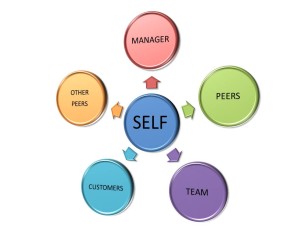Most people have heard of 360 feedback: getting feedback from your manager, peers and direct reports in order to get a good overview of your strengths and development areas. However, have you thought of how your leadership should be skilled outwardly in all directions, communicating effectively with all those around you?
In order to lead well, you have to be able to communicate, appreciate and adapt your style for your manager, peers and direct reports, but also to customers, internal departments, stakeholders and service providers. And it all starts with understanding yourself.
You’re going to need to be able to build relationships, and influence, negotiate with, empower and engage those around you. Therefore, one of the most important characteristics of a good leader is self-awareness. It’s important to understand what triggers motivation, stress and specific reactions in yourself, and helps or hinders your decision making. Additionally, what you believe about yourself and others (both positive and negative) is not only going to affect your behaviour and leadership style, but also the way you see and work with others around you.
Developing your skills in the following are important for all those leadership relationships in the circle. All communication can be enhanced by understanding and appreciating the differences of individuals in terms of:
- Motivational needs – the important motivating triggers that can feel rewarding or cause the “barriers” to go up if you get it wrong (including a sense of significance, autonomy, competence, fairness, certainty, connection).
- Motivated “towards” or “away from” situations. For example, towards rewards, promotion, incentives, or away from redundancy, boredom, career stagnation.
- Beliefs and values – understanding positive and negative beliefs at play and the non-negotiable management and leadership rules and values which need to be maintained even when under pressure eg. What is the line that cannot be crossed.
- Cognitive biases – the unconscious ‘rules of thumb’ that people acquire from experience that act as shortcuts to making decisions instead of making exhaustive evaluations of relevant information.
- Working preferences – organised and structured versus flexible and spontaneous
- Preferences on how to handle conflict – avoiding, accommodating, competing, collaborating, compromising.
- Learning and language styles which need to be incorporated into your communication i.e. visual, auditory, kinaesthetic.
- Building an environment of trust, honesty, openness and learning from successes and mistakes.
The above can be used when communicating to everyone. Then you can add specifics for each group within the 360 degree view. As an example, here are suggestions for enhancing the communication with your manager (AKA managing upwards!):
- Take responsibility for the relationship and, if your boss doesn’t come to you, then it’s up to you to establish regular contact.
- Rather than running the risk that your boss could interpret your style differences as disrespect or incompetence, establish a way of communicating your preferences to help them understand you better.
- How do they define success, what are their priorities, what do they care about and what goals are important to them? Understand and negotiate timelines and performance measurements.
- How does your boss like to communicate and be communicated to – emails or verbal, summary or details, structured or informal meetings?
- What kinds of decisions does your boss want to be involved in, and what do they want you to handle?
What should you now be considering when communicating with peers, other peers (such as other departments, stakeholders, service providers), and importantly, your customers?
If you would like further information or help, we can provide 1-2-1 executive coaching or specific coaching workshops for teams to cover the full 360 degrees. Please contact us for more details.

